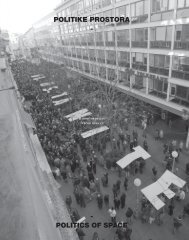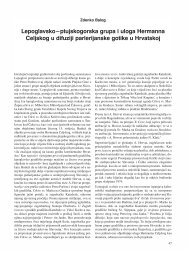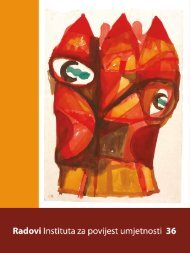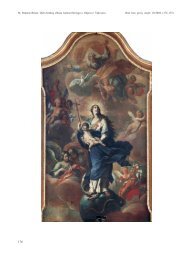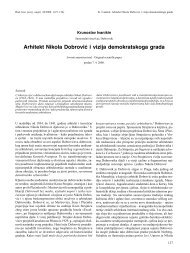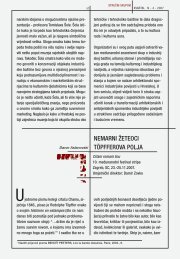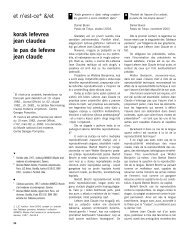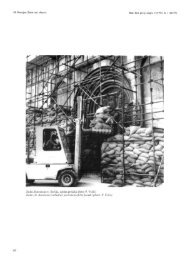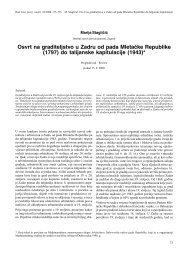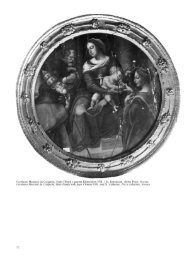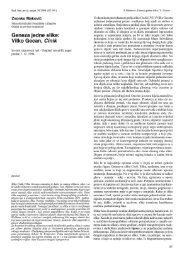DRUGA STRANA DIZAJNA - - ANOTHER SIDE OF DESIGN
DRUGA STRANA DIZAJNA - - ANOTHER SIDE OF DESIGN
DRUGA STRANA DIZAJNA - - ANOTHER SIDE OF DESIGN
You also want an ePaper? Increase the reach of your titles
YUMPU automatically turns print PDFs into web optimized ePapers that Google loves.
138<br />
druga strana dizajna<br />
-<br />
-<br />
KoraljKa<br />
vlajo<br />
-<br />
-<br />
another side of design
Prelaženje donedavno čvrsto određenih granica<br />
između disciplina posudbom metoda, izričaja i<br />
pristupa česta je praksa u suvremenim umjetničko-<br />
dizajnerskim krugovima, a 40. zagrebački salon<br />
(Sinergije) i Pregled hrvatskog dizajna 0708 ukazali<br />
su na više kvalitetnih primjera i iz hrvatske prakse.<br />
Autori – skupine studenata ili profesionalaca iz<br />
različitih stručnih područja ili pak pojedinci koji<br />
napuštaju sigurnost vlastitog područja djelovanja,<br />
upravo su u ovom nedefiniranom borderlandu našli<br />
kontekst za eksperiment i kritičko promišljanje.<br />
Dijelom je to nasljedstvo postmodernističkog<br />
nastojanja da se razbiju staklena zvona oko dotad<br />
strogo izoliranih disciplina, dijelom posljedica<br />
dosad neslućenih mogućnosti razmjene informacija<br />
i utjecaja. Dijelom je razlog i činjenica da su se<br />
ekonomski interesi našli u snažnoj opoziciji s<br />
društvenim vrijednostima i doveli do «zbijanja<br />
redova» među istomišljenicima.<br />
U suvremenom potrošačkom društvu dizajn je<br />
spretno asimiliran u marketinški vokabular kao<br />
svojevrsna garancija dobrog ukusa, kvalitete ili<br />
prestiža. Površno gledajući, položaj dizajna/dizajnera<br />
(na Zapadu) nikada nije bio bolji: dizajn je napokon<br />
Crossing the boundaries between disciplines, firmly<br />
established until recently, by borrowing methods,<br />
expressions, and approaches has been a common<br />
practice of today’s artistic and designer circles. The<br />
40th Zagreb Salon (Synergies) and the Overview of<br />
Croatian Design 0708 presented several prominent<br />
examples from the Croatian practice.<br />
It is precisely in this undefined borderland that many<br />
authors – groups of students or professionals from<br />
various fields, or individuals that have decided to<br />
leave the safety of their own field of activity – have<br />
found a suitable context for experimentation and<br />
critical reflection. It has partly happened owing to<br />
the inherited post-modernist tendency of breaking<br />
the ivory towers around the hitherto isolated<br />
disciplines, and partly as a consequence of the yet<br />
unseen possibilities of exchange of information and<br />
influences. Partly it is also the fact that economic<br />
interests have come to be sharply opposed to social<br />
values, thus causing the “closing of ranks” with<br />
those that endorsed similar principles.<br />
In the contemporary consumerist society, design<br />
has been skilfully assimilated into the marketing<br />
vocabulary as somehow guaranteeing good taste,<br />
časopis za suvremena likovna zbivanja<br />
magazine for contemporary visual arts<br />
prihvaćen kao važan dio proizvodnog procesa, broj<br />
dizajnera zaposlen u industriji veći je no ikad, a od<br />
njih je dio promoviran u međunarodne zvijezde.<br />
Međutim, onaj dizajn čiji cilj nije instant-profit<br />
osuđen je na margine javnog djelovanja.<br />
«Rubna» ili alternativna područja dizajna nalaze<br />
se izvan fokusa masovne proizvodnje i potrošnje.<br />
Takvi radovi zastaju na konceptu, unikatu ili, u<br />
najboljem slučaju, na maloserijskoj proizvodnji.<br />
Prvenstveno, dakle, govorim o proizvodnom<br />
dizajnu 1 na samom rubu industrijske proizvodnje,<br />
a interesi su mu isprepleteni s tradicionalnim<br />
područjima interesa (primijenjenih) umjetnosti.<br />
Razdvojen od industrije uz koju je donedavno bio<br />
vezan pupčanom vrpcom, proizvodni dizajn otkriva<br />
svoj društveno-politički potencijal.<br />
Određivanje granica na relaciji umjetnost –<br />
primijenjene umjetnosti – dizajn jedno je od ključnih<br />
pitanja u povijesti dizajna. Nova se disciplina za<br />
svoj status izborila upravo određujući se naspram<br />
tradicionalnoga umjetničkog obrta. S druge strane,<br />
brisanje artificijelnih razlika 2 između čiste umjetnosti<br />
i suvremene umjetnosti oblikovanja teorijska je<br />
pozicija na kojoj su inzistirali i EXAT 51 i Bernardo<br />
quality, or prestige. Superficially seen, the position<br />
of design/designers (in the West) has never been<br />
better: design is now finally acknowledged as an<br />
important segment of the production process, the<br />
number of designers employed in industry is larger<br />
than ever, and many among them have become<br />
international celebrities.<br />
Nevertheless, design that has aims other than<br />
instant profit is condemned to remaining on<br />
the margins of public life. These “marginal” or<br />
alternative fields of design are out of focus for mass<br />
production and consumption. Such projects are<br />
bound to remain on the level of concept or become<br />
a unique item, at best a small series. I am primarily<br />
referring to product design, 1 which is situated on<br />
the very edge of industrial production and has<br />
interests that are intertwined with the traditional<br />
interest fields of (applied) arts. Separated from<br />
industry, with which it was once inseparably linked,<br />
product design could finally discover its socio-<br />
political potential.<br />
Setting boundaries between art, applied arts,<br />
and design is among the crucial issues in the<br />
history of design. The new discipline achieved<br />
139
140<br />
Bernardi i Zvonimir Radić.<br />
Primjerenost miješanja komercijalnog i umjetničkog 3<br />
i slučajevi «One off»-a ili posprdno nazvanog<br />
galerijskog dizajna 4 (koji nastaje isključivo radi<br />
izlaganja u galerijama) inspiriraju žustre rasprave<br />
o svrsi i ciljevima dizajna. Iako nema sumnje da je<br />
ponekad tzv. galerijski dizajn manipulacija javnosti,<br />
bilo da je riječ o umjetno ograničenim serijama da bi<br />
im se pridodala ekskluzivnost 5 ili o unikatima čiji je<br />
jedini cilj postojanja samopromocija, uglavnom mu<br />
se ne može osporiti hrabrost eksperimentiranja.<br />
Vrijednost alternativnog dizajna upravo je u<br />
eksperimentu, propitivanju kako mogućnosti<br />
i posljedica novih tehnologija tako i<br />
vrijednosti društva unutar kojega je nastao.<br />
U superpotrošačkom društvu, u kojemu je<br />
posjedovanje ključna vrednota, dizajn je idealan<br />
medij za komuniciranje ideja. Nove ideje rađaju se<br />
na marginama, gdje je sloboda eksperimentiranja<br />
najveća.<br />
Ako je mainstream-dizajn ogledalo društva u kojem<br />
je nastao, onda je rubni dizajn njegova kristalna<br />
kugla.<br />
its status precisely by defining itself with respect<br />
to traditional artistic crafts. On the other hand,<br />
erasing artificial differences 2 between pure art<br />
and the contemporary art of craft is a theoretical<br />
position on which EXAT 51, Bernardo Bernardi, and<br />
Zvonimir Radić equally insisted.<br />
The adequacy of mixing commercial and artistic<br />
aspects 3 and the cases of “One off” or that which<br />
has been mockingly called gallery design 4 (made<br />
exclusively in order to be exhibited in galleries)<br />
have inspired vehement debates about the purpose<br />
and aims of design. Even though there is no doubt<br />
that the so-called gallery design has sometimes<br />
manipulated the public, regardless of whether it<br />
was produced in artificially limited series so as<br />
to add a touch of exclusiveness 5 or consisted<br />
of unique items with the sole purpose of self-<br />
promotion, generally it must be credited with daring<br />
experimentation.<br />
The value of alternative design is indeed in<br />
experimenting, since it questions both the<br />
possibilities and the consequences of new<br />
technologies, as well as the values of the society in<br />
which it emerges. In a super-consumerist society,<br />
Less is more; less is bore; less + more<br />
Govorimo li o alternativnom kao nečemu što se<br />
otklanja od uobičajenog, zanimljivo je razmotriti<br />
kakav je uopće prevladavajući odnos industrije i<br />
dizajna 6 u zapadnom društvu.<br />
Omit the Unimportant. Dieter Rams 7<br />
Početkom 20. stoljeća dizajn se kao nova disciplina<br />
nametao industriji kao neizostavni partner, spremno<br />
prihvativši njezine zakonitosti. A zašto i ne?<br />
Industrijalizacija je obećavala društveno pravedniji<br />
svijet obilja - jeftinih, kvalitetnih, svima dostupnih<br />
proizvoda. Do sredine 70-ih, dizajner – onaj koji<br />
rješava probleme, prevoditelj između industrije i<br />
čovjeka – zastupao je racionalnu estetiku izvedenu<br />
iz funkcije, ergonomičnosti i proizvodljivosti.<br />
Modernistička utopija o univerzalnom jeziku – jeziku<br />
strogo određenog izričaja i jednoznačno definirane<br />
funkcije – nametala se kao jedini ispravan put<br />
industrijalizacije svijeta. U potrebi za otklonom<br />
od historicističke tradicije oblikovanja i ujedno<br />
prihvaćajući datost tadašnjih mogućnosti industrije,<br />
dizajn modernizma inzistirao je na standardizaciji,<br />
in which possession is the key value, design is<br />
an ideal medium for communicating ideas. New<br />
ideas are born on the margins, where one can<br />
experiment more freely than anywhere else.<br />
If mainstream design is a mirror of the society<br />
in which it emerges, then marginal design is its<br />
crystal ball.<br />
Less is more; less is bore; less + more<br />
Speaking about the alternative as something that is<br />
detached from the commonplace, it is interesting to<br />
consider what is the prevailing relationship between<br />
industry 6 and design in the Western societies.<br />
Omit the Unimportant. Dieter Rams 7<br />
Early in the 20th century, design was a new<br />
discipline, imposing itself on industry as its<br />
inevitable partner and readily accepting its laws.<br />
Why not? Industrialisation was promising social<br />
justice and a world of plenty – cheap and good<br />
products that would be accessible to everybody.<br />
Before the mid-70s, the designer – the one who<br />
solves problems, the interpreter between industry<br />
and man – endorsed an aestheticism that was<br />
-<br />
koraljka<br />
vlajo<br />
-
druga<br />
strana<br />
dizajna<br />
-<br />
-<br />
another<br />
side of<br />
design<br />
simplifikaciji i stvaranju estetike neovisne o<br />
povijesnim i kulturološkim referencijama.<br />
«U pojednostavljivanju kompleksnost kultura je<br />
izgubljena(...)» 8<br />
S postmodernističkim određivanjem predmeta<br />
kao komunikacijskog medija pitanje je funkcije<br />
relativizirano; u središtu pozornosti njegova je<br />
zapostavljena semantička vrijednost. Nastavljajući<br />
se na popartovske eksperimente i talijanski<br />
radikalni dizajn, Studio Alchimia a zatim i Memphis<br />
burno se razvode od modernističke dogme. Žarište<br />
je postmodernističke kritike ‘esperanto’ strojevnoga<br />
doba koji inzistira na jednoznačnosti umjesto<br />
mnogoznačnosti, a predmet izdvaja iz društvenog<br />
konteksta.<br />
S obzirom na Memphisov drastični zaokret od<br />
etablirane estetike, ne čudi početna rezerviranost<br />
industrije: većina Memphisovih predmeta<br />
proizvedena je kao unikat ili u ograničenoj seriji.<br />
Važno je, međutim, naglasiti da je Memphis ipak<br />
proizvod osamdesetih, desetljeća izobilja i rasipanja<br />
zaliha, pa kritika konzumerizma nije u središtu<br />
based on functionality, ergonomy, and feasibility.<br />
The modernist utopia of universal language – a<br />
language of strict and accurate expression and a<br />
uniformly defined function – was imposing itself as<br />
the only appropriate way to industrialize the world.<br />
In its need to detach itself from the historicist<br />
tradition of craft, while accepting at the same time<br />
the possibilities offered by the industry, modernist<br />
design insisted on standardization, simplification,<br />
and the creation of an aestheticism that would be<br />
independent from historical and cultural references.<br />
«In simplifying, the complexity of cultures<br />
was lost(...)» 8<br />
The post-modernist definition of object as a<br />
medium of communication relativized the question<br />
of function and its neglected semantic value was<br />
now in the focus of attention. Basing themselves<br />
on pop-art experiments and Italian radical<br />
design, Studio Alchimia and then Memphis were<br />
energetically rejecting the modernist dogma. The<br />
focus of post-modernist criticism was the ‘lingua<br />
franca’ of the machine age, which insisted on<br />
clarity instead of ambiguity, while separating the<br />
časopis za suvremena likovna zbivanja<br />
magazine for contemporary visual arts<br />
pozornosti njegovih članova. Memphis stvara za<br />
suvremenu kulturu, dizajnira za potrošnju. 9<br />
S vremenom je industrija široke potrošnje asimilirala<br />
postmodernističku estetiku, prilagodivši je vlastitim<br />
potrebama. Površnim stilističkim čitanjem preuzela<br />
je šarenilo pastelnih boja, oblika i uzoraka.<br />
Memphis je raspušten u trenutku kada je masovna<br />
proizvodnja postala njegova parodija.<br />
Gdje su dizajneri danas? Negdje između sumnje<br />
i otriježnjenosti.<br />
U sektoru široke potrošnje dizajn je – uz hvale<br />
vrijedne iznimke – trivijaliziran: postao je glorificirani<br />
marketinški alat, sredstvo za proizvodnju upitne<br />
dodatne vrijednosti. Dizajnerovo viđenje pojma<br />
(unapređivanje proizvoda za dobrobit korisnika)<br />
nije neumitno istoznačno definiciji proizvođača.<br />
Industrija, razumljivo, bježi od rizika: rijetke su<br />
tvrtke spremne investirati sredstva u zaista nove<br />
proizvode. 10<br />
U ostvarivanju svoga primarnog cilja – zarade,<br />
industrija široke potrošnje ovisna je o stalnom<br />
širenju tržišta i ubrzanom zastarijevanju proizvoda.<br />
Dizajner, odgajan kao posrednik između industrije<br />
object from its social context.<br />
As to Memphis’s drastic negation of the established<br />
aesthetics, the initial scepticism of industry was<br />
hardly surprising: most of Memphis’s objects<br />
were made as unique items or in a limited series.<br />
However, it should be noted that, after all, Memphis<br />
was a product of the 80s, the decade of plenty and<br />
of squandering reserves, even of consumerism;<br />
therefore, its members did not place the critique<br />
of consumerism into the focus of their attention.<br />
Memphis works for contemporary culture, it<br />
designs for consumption. 9<br />
With time, the industry of common goods<br />
assimilated the post-modernist aestheticism by<br />
adapting it to its own needs. In its superficial stylistic<br />
interpretation, it was appropriating the colourful<br />
range of pastel colours, shapes, and patterns.<br />
Memphis ceased its existence at the moment when<br />
mass production had become its parody.<br />
Where do designers stand today? Somewhere<br />
between doubt and sobriety.<br />
In the common goods sector, design has been<br />
trivialized, albeit with some noteworthy exceptions:<br />
it has become a glorified marketing tool, a means<br />
141
142<br />
i čovjeka koji miri zahtjeve obje strane, nalazi se u<br />
šizofrenom položaju mirenja dijametralno suprotnih<br />
potreba klijenta i korisnika.<br />
Unatoč plemenitim idejama, dizajn se još uvijek (ili<br />
više no ikad) percipira kao stilsko sredstvo, nagovor<br />
na kupnju – bilo kao promotor trenda ili dizajnerskim<br />
potpisom. 11<br />
Suvremeno zapadno društvo zaista je i ostvarilo<br />
modernističku težnju proizvodima dostupnima<br />
većini, no po cijenu eksploatacije zemalja trećeg<br />
svijeta, zagađenja okoliša i rasipanja zaliha.<br />
Papanekovo upiranje prstom u dizajn (kao jedno<br />
od najštetnijih zanimanja) pretjerano je utoliko<br />
što dizajneru pripisuje daleko veće ovlasti no što<br />
ih ovaj zaista ima; međutim, potpuno odricanje<br />
odgovornosti također je pogrešno. Ni tehnologiji ni<br />
industrijskom dizajnu ne može se odreći političnost<br />
naSlOnjač OD ODbačene tkanIne,<br />
TEjO REMy ZA DROOG<br />
of producing the questionable added value. The<br />
designer’s view of the term (improving the product<br />
for the sake of the user) is not necessarily the same<br />
as the producer’s definition. It is understandable<br />
that industry is always trying to avoid risk:<br />
companies rarely show themselves ready to invest<br />
in truly innovative products. 10<br />
While realizing its primary goal, which is profit,<br />
the common goods industry depends on the<br />
permanent expansion of the market and the limited<br />
expiration date of its products. Trained as the<br />
intermediary between industry and man, the one<br />
to appease both sides, the designer has found<br />
himself in the schizophrenic position of someone<br />
who is trying to reconcile the diametrically opposite<br />
needs of his clients and users.<br />
Despite all the noble principles, design is still (and<br />
|<br />
|<br />
Rag ChaIR, TEjO REMy fOR DROOG,<br />
ARMCHAIR Of DISCARDED fABRIC<br />
– onaj koji upravlja tehnologijom (pa tako i dizajnom)<br />
posjeduje moć. Odabir projekta, tehnologije i<br />
metode ovisi o nečijim interesima. Pitanje je jesu li ti<br />
interesi na strani Čovjeka: industrija i napredak nisu<br />
nužno ista strana medalje.<br />
Kada govorim o «dizajnerskoj sumnjičavosti»,<br />
mislim na sumnju o kojoj govori Meurer 12 - sumnju<br />
kao suprotnost apsolutnoj uvjerenosti (dogma) u<br />
ispravnost svojih postupaka. Sumnja je posljedica<br />
nesigurnosti, a nesigurnost poticaj na preispitivanje<br />
postupaka, mišljenja i ideja. Sumnja je preduvjet za<br />
kreativnost. 13<br />
Nakon razuzdanih osamdesetih devedesete su<br />
donijele otriježnjenost – svijest o konačnosti zaliha,<br />
o posljedicama zagađivanja i pretjerane potrošnje.<br />
U suvremenom dizajnerskom razmišljanju sve<br />
je izraženija sumnja u ispravnost postupaka<br />
perhaps more than ever) perceived as a stylistic<br />
tool, an argument for purchasing something – be<br />
it by promoting a trend or because it bears a<br />
designer signature. 11<br />
kOMODa,<br />
TEjO REMy ZA DROOG, 1991.<br />
The modern Western societies have actually<br />
realized the modernist wish to create products that<br />
would be accessible to most people, but at the<br />
price of exploiting the Third World, polluting the<br />
environment, and squandering the resources.<br />
Papanek’s pointing the finger at designers (as<br />
one of the most harmful professions) is perhaps<br />
exaggerated, since it attributes to them more<br />
power than they actually have; however, it<br />
would also be wrong to say that they have no<br />
responsibility. Neither the technology nor industrial<br />
design can deny being politicised – those who rule<br />
over technology (and thus over design) do possess<br />
|<br />
|<br />
CheSt Of DRaweRS,<br />
TEjO REMy fOR DROOG, 1991<br />
-<br />
koraljka<br />
vlajo<br />
-
druga<br />
strana<br />
dizajna<br />
-<br />
-<br />
another<br />
side of<br />
design<br />
suvremene industrije.<br />
Etika postaje jednako važna kao estetika. Dizajner<br />
se ne identificira s ulogom «rješavatelja», već<br />
«uočavatelja» problema: onog koji postavlja<br />
neugodna pitanja. je li etično rješavati dizajnerski<br />
problem koji je zadala industrija ako ta industrija<br />
šteti čovjeku i okolini? 14 Da li je etično tehnologiju<br />
činiti ugodnom za upotrebu ako ona otuđuje i<br />
zadire u privatnost?<br />
Od potrošača do korisnika<br />
jedno od prvih (vječno rubnih) područja na kojem<br />
su dizajneri oštrili svoje etičke oštrice – ekodizajn<br />
– posljednjih je godina značajnije prisutan<br />
u industrijskoj proizvodnji, prije svega zbog<br />
određenih pomaka u svijesti korisnika te stoga<br />
i medijske eksponiranosti teme, pa i uvođenja<br />
power. The choice of projects, technologies, and<br />
methods always depends on someone’s interests.<br />
The question to be asked is whether these interests<br />
are on the side of Man: for industry and progress are<br />
not necessarily the same side of the medal.<br />
Speaking about the “designers’ doubt”, I am<br />
referring to the doubt mentioned by Meurer, 12<br />
namely that which is opposed to absolute conviction<br />
(dogma) about the justification of one’s deeds.<br />
Doubt originates in insecurity, while insecurity leads<br />
one to question one’s deeds, thoughts, and ideas.<br />
Doubt is prerequisite for creativity. 13<br />
following the reckless 80s, the 90s would bring<br />
sobriety – the awareness of limited resources,<br />
knowledge of the consequences of pollution and<br />
overconsumption. In contemporary designer<br />
thinking, there is an increasing doubt about the<br />
časopis za suvremena likovna zbivanja<br />
klUPa - DeblO,<br />
jURGEN BEy ZA DROOG, 1999.<br />
|<br />
|<br />
tRee tRUnk benCh,<br />
jURGEN BEy fOR DROOG, 1999<br />
magazine for contemporary visual arts<br />
strožih ekoloških zakona. Međutim, za većinu tvrtki<br />
ekodizajn je tek dio odnosa s javnošću: tvrtke još<br />
uvijek više ulažu u promociju svoje ekoproizvodnje<br />
no u samu ekoproizvodnju. 15<br />
U konačnici, kakva je korist od ekološki<br />
proizvedenog mobilnog telefona ako je to tek još<br />
jedan ubrzo odbačeni telefon? Osim toga, kako<br />
dokazuje john Thackara, 16 ekologičnost takvih<br />
proizvoda upitna je ako se uzme u obzir njihov<br />
ukupan razvojni put te kada se zbroji konačan<br />
ekološki trag (ekološki prtljag) koji za sobom<br />
ostavljaju. Površno shvaćen, ekološki dizajn daje<br />
alibi konzumerizmu.<br />
Rješenje problema mnogi suvremeni dizajneri<br />
i teoretičari – od Drooga do Thackare – nalaze<br />
u radikalnom socioekonomskom zaokretu –<br />
odbacivanju konzumerizma. Utopija 21. stoljeća<br />
justification of methods employed by contemporary<br />
industry. Thus, ethics is becoming equally important<br />
as the aesthetics. The designer is no longer equated<br />
with the “one who brings solutions,” but with the<br />
“one who identifies problems” and asks unpleasant<br />
questions. Is it ethical to solve a design problem<br />
imposed by the industry if that industry harms<br />
man and his environment? 14 Is it ethical to make<br />
technology pleasant to use if it alienates people and<br />
violates their privacy?<br />
From Consumer to User<br />
One of the first (forever marginal) areas in which<br />
designers have sharpened their ethical edge – namely<br />
eco-design – has recently become significantly<br />
present in industrial production, primarily owing to<br />
a shift in the users’ awareness and the subsequent<br />
143
144<br />
u dijametralnoj je suprotnosti s modernističkom<br />
utopijom (svima pristupačnog proizvoda), i<br />
predviđa održivo društvo koje se ne temelji na<br />
vlasništvu (predmetu) nego na suradnji (akciji). 17<br />
Industrija bi trebala biti alat u rukama dizajnera, a<br />
ne obratno. 18<br />
Kao što se Memphisovo pojavljivanje na<br />
dizajnerskoj sceni povezuje s postmodernizmom<br />
u dizajnu, tako se i nizozemskom Droogu pripisuje<br />
početni zamah u promociji «novog» dizajna.<br />
Duhovito propitivanje društvenih vrijednosti, kritika<br />
konzumerizma, naglašavanje procesa upotrebe<br />
proizvoda i njihovo elegantno starenje teme su koje<br />
je Droog nametnuo na inicijalnoj milanskoj izložbi<br />
1993. a u žarištu su interesa novih generacija<br />
dizajnera na rubu industrije.<br />
Droogova izvedenica modernističke krilatice –<br />
less+more 19 – zasniva se na ideji o proizvodu kao<br />
mediju, dakle naslanja se na semantičke teorije<br />
postmodernizma te konceptu iza proizvoda pridaje<br />
jednaku važnost kao i samom proizvodu. No, za<br />
razliku od stilski osviještenog Memphisa (B. Radice<br />
uspoređuje ga s modom), novim stremljenjima<br />
u dizajnu teško je odrediti obuhvatne stilske<br />
karakteristike.<br />
takkIaInen, ANTEEKSI, 2000.,<br />
“jAKNA ZA USAMljENE” PREKRIVENA ČIČAK TRAKAMA<br />
|<br />
takkIaInen, ANTEEKSI, 2000.,<br />
“jACKET fOR lONElIES” WITH THISTlE STRAPS<br />
-<br />
Droogovi radovi, ili, primjerice, radovi finske grupe<br />
Anteeksi, švedskog Uglycute ili britanske grupe<br />
&made nisu «zgodni», niti posjeduju očekivano<br />
savršenstvo forme koja posredno obećava<br />
kvalitetu. Otkrivanje novog dizajnerskog vokabulara<br />
u tretmanu materijala, tehnologija i tipologija<br />
rezultira vizualno uznemirujućim proizvodima.<br />
Novi pristup dizajnu svoju pobunu protiv<br />
etabliranog sistema uvijek navještava narušavanjem<br />
estetskih normi. U ovom slučaju kritika je usmjerena<br />
na suvremeno (an)estetizirano društvo i masovnu<br />
proizvodnju baziranu na poslušnim, statistički<br />
istovjetnim potrošačima. Ružni realizam, kako ga<br />
naziva Hella jongerius, nudi se kao alternativa<br />
uniformiranosti i savršenstvu industrijskih<br />
proizvoda. Autori poput jerszya Seymoura ili<br />
Maartena Baasa u svom radu revaloriziraju upravo<br />
estetske norme i pitanje ružnoće. Kolekcija Scum<br />
jerszya Seymoura nastala je kapanjem izolacijske<br />
pjene; seriju namještaja Clay Baas je izveo grubim<br />
nanošenjem gline na osnovnu metalnu strukturu.<br />
Ružnoća i sirovost vraćaju dizajnu život. 20<br />
-<br />
koraljka<br />
vlajo<br />
-
druga<br />
strana<br />
dizajna<br />
-<br />
-<br />
another<br />
side of<br />
design<br />
U pozitivnoj manifestaciji trenda, povratak obrtnoj/<br />
manufakturnoj proizvodnji inspiriran je upravo<br />
potragom za autentičnošću izraza, bijegom od<br />
nametnute estetike, i željom za eksperimentom.<br />
U tom smislu zanimljiv je primjer novog (Ili prvog?<br />
Islandski dizajn nije slijedio uspješan razvojni<br />
put ostalih nordijskih zemalja.) vala islandskog<br />
dizajna koji svoju reputaciju gradi upravo na nikad<br />
prekinutoj vezi s obrtom i – manjku zaliha. Nužna<br />
reciklaža proizvoda, vitalna obrtna proizvodnja,<br />
snalažljivost i sklonost eksperimentu, inspirirali<br />
su intrigantan hibrid novih i starih tehnologija/<br />
exposure of the topic in the media, as well as the<br />
enactment of stricter ecological laws. However,<br />
for most companies eco-design is only a segment<br />
of their public relations: they still invest in the<br />
promotion of their eco-production far more than in<br />
the eco-production itself. 15<br />
After all, what is the use of an ecologically<br />
produced cell phone if it is discarded as quickly<br />
as any other? Besides, as john Thackara has<br />
demonstrated, 16 the ecological nature of such<br />
products is questionable if one takes into account<br />
their entire path of development and sums up the<br />
ecological footprints (eco-baggage) that they leave<br />
behind. Superficially understood, eco-design offers<br />
an alibi to consumerism.<br />
A number of contemporary designers and<br />
theoreticians – from Droog to Thackara – find<br />
a solution to this problem in a radical socio-<br />
economic turn – the rejection of consumerism.<br />
The 21st-century utopia is diametrically opposite<br />
to the modernist one (the utopia about universally<br />
accessible products) and presupposes a<br />
sustainable society that is based on cooperation<br />
(action) rather than possession (object). 17<br />
-<br />
KOlEKCIjA Pjena, jERSZy SEyMOUR<br />
|<br />
SCUM COllECTION, jERSZy SEyMOUR<br />
časopis za suvremena likovna zbivanja<br />
magazine for contemporary visual arts<br />
metoda/tipologija. Čak i donedavni riblji otpad (riba<br />
je osnovni islandski izvozni proizvod) pokazao se<br />
kao više no izdašna dizajnerska sirovina. Islandski<br />
dizajneri upotrebljavaju sve – od riblje kože u<br />
modnoj industriji do dječjih igračaka od ribljih kosti.<br />
Konačno, svojevrstan dizajnerski spomenik ribi<br />
podigla je Dogg Gudmundsdóttir 2002. godine<br />
svjetiljkama od sušene ribe Cod lamp.<br />
Dizajneri se ne ustručavaju miješati tzv. nisku<br />
i visoku tehnologiju, a upravo zahvaljujući<br />
mogućnostima eksperimentiranja u slobodnijem<br />
obrtnom okruženju dio proizvoda zatim probija<br />
Industry should be a tool in designer’s hands and<br />
not vice versa. 18<br />
As Memphis’s emergence on the designer scene<br />
is commonly associated with post-modernism in<br />
design, the Dutch studio Droog has been attributed<br />
with giving the initial impetus to the promotion of<br />
“new” design.<br />
Humorous questioning of social values, a critique<br />
of consumerism, an emphasis on the process of<br />
using the product and its elegant aging – these are<br />
the topics that Droog imposed to the first Milan<br />
exhibition in 1993, and they were also in the focus<br />
of interest for the new generations on the margins<br />
of industry.<br />
Droog’s version of the modernist slogan less+more<br />
19 is based on the idea of the product as a medium,<br />
thus basing itself on the semantic theories of post-<br />
modernism and giving equal importance to the<br />
concept behind a product as to the product itself.<br />
However, unlike the stylistically conscious Memphis<br />
(B. Radice has compared it to fashion), it is difficult<br />
to determine some comprehensive features of style<br />
when it comes to these new tendencies in design.<br />
-<br />
SvjetIljka bakalaR, DOGG GUDMUNDSDOTTIR, 2002.<br />
Droog’s projects, like those of the finnish Anteeksi,<br />
|<br />
COD laMP, DOGG GUDMUNDSDOTTIR, 2002<br />
145
146<br />
granicu industrijske proizvodnje. Demakersvanov<br />
proizvod lace fence (2005.), diplomski projekt<br />
joepa Verhovena – inspiriran je tradicionalnom<br />
nizozemskom čipkom: uvođenjem novog, za<br />
‘pletenje’ podatnijeg materijala uniformnu<br />
industrijsku ogradu pretvara u potpuno novi<br />
proizvod.<br />
Isto tako, prva verzija knotted chair (1996.) Marcela<br />
Wandersa proizvedena je ručno – kombinacijom<br />
tradicionalne tehnike (pletenja) i novog materijala –<br />
karbonskih i aramidskih vlakana, a od 2001. godine<br />
proizvodi je Capellini.<br />
Pobuna protiv konzumerističkog lifestylea očituje se<br />
u ponovnom vrednovanju odbačenog i u subverziji<br />
industrije koja ovisi o brzoj izmjeni proizvoda.<br />
formiranje emocionalnih veza između predmeta<br />
i korisnika jedna je od ključnih preokupacija<br />
alternativnog dizajna. Predmeti i interijeri koji<br />
elegantno stare i zahtijevaju akciju/reakciju<br />
korisnika, pa im vrijednost ne ovisi o «novini»,<br />
nego značenje kreiraju upotrebom, predmeti<br />
su koje su vlasnici skloniji zadržati no odbaciti.<br />
Tretman proizvoda može se usporediti s razlikom<br />
između fast i slow food-koncepta u kulinarstvu:<br />
-<br />
čIPkaSta OgRaDa, DEMAKERSVAN, 2005.,<br />
HUMANIZACIjA INDUSTRIjSKE, ČElIČNE OGRADE<br />
Sweedish Uglycute, or British &made, are neither<br />
“cute” nor possess the expected perfection of<br />
form that indirectly promises quality. The discovery<br />
of a new designer vocabulary in the treatment<br />
of materials, technologies, and typologies has<br />
resulted in visually disturbing products.<br />
All new approaches to design have proclaimed<br />
their rebellion against the established system<br />
by violating aesthetical norms. In this case,<br />
criticism has been directed at the contemporary<br />
aestheticised (or anesthesized) society and the<br />
mass production based on obedient, statistically<br />
identical consumers. The ugly realism, a term<br />
|<br />
laCefenCe, DEMAKERSVAN, 2005.,<br />
HUMANISING INDUSTRIAl, STEEl fENCE<br />
konzumacija (prežderavanje) naspram užitka u<br />
procesu upotrebe.<br />
Već neko vrijeme nameće se teza o vremenu u<br />
kojem živimo kao «informatičkom dobu», premda<br />
je ono još uvijek ovisno o zastarjelim metodama<br />
coined by Hella jongerius, has offered itself as<br />
an alternative to the uniformity and perfection<br />
of industrial products. Authors such as jerszy<br />
Seymour or Maarten Baas have re-evaluated<br />
precisely those aesthetical norms and the issue<br />
of ugliness in their work. The Scum collection<br />
by jerszy Seymour was created from drops of<br />
isolation foam, while Baas’s furniture series called<br />
Clay was produced from coarse layers of clay,<br />
applied onto a basic metal structure. what ugliness<br />
or rawness can bring is a kind of vitality back to<br />
design. 20<br />
StOlICa S čvOROvIMa, MARCEl WANDERS,<br />
CAPPEllINI, 2001.<br />
|<br />
knOtteD ChaIR, MARCEl WANDERS,<br />
CAPPEllINI, 2001<br />
-<br />
-<br />
koraljka<br />
vlajo<br />
-
druga<br />
strana<br />
dizajna<br />
-<br />
-<br />
another<br />
side of<br />
design<br />
proizvodnje. Naš društveni okoliš se promijenio,<br />
no industrija pa i mainstream industrijski dizajn<br />
maniristički podržavaju status quo sredine 20.<br />
stoljeća.<br />
Dizajn, ako želi ostati relevantan, mora reagirati<br />
na društvene, ekonomske, kulturološke i<br />
tehnološke promjene, pa, logično, preuzima i<br />
aktivističku ulogu. 21<br />
Riječ je prije svega o konceptualnom dizajnu koji<br />
upotrebljava dizajnerska rješenja da bi isprovocirao<br />
diskusiju, akciju, i razotkrio stereotipe. Možda<br />
je najizravniji primjer dizajnerova političkog<br />
aktivizma koncept odijela oklopa za sudionike<br />
uličnih demonstracija Suited for Subversion (2002.)<br />
umjetnika/dizajnera/tehnologa Ralpha Borlanda.<br />
Slične pobude vode autore koji kritički reagiraju na<br />
devastaciju urbanog prostora. Umrtvljivanje urbanih<br />
središta logična je posljedica konzumerizma i<br />
zadiranja privatnih u javne interese.<br />
Može se povući vrlo jasna paralela između<br />
uniformne savršenosti koju nudi suvremena<br />
industrijska proizvodnja i nasilno estetizirane<br />
urbane okoline. Element slučajnosti jednako je<br />
nepoželjan u industrijskoj proizvodnji 22 kao i u<br />
In a positive manifestation of the trend, return to<br />
the manual or manufacture production has been<br />
inspired precisely by the search for authenticity of<br />
expression, a flight from the imposed aesthetics,<br />
and a desire to experiment. An interesting example<br />
in that sense is that of the new wave of Islandic<br />
design (or was it the first wave? Islandic design<br />
did not follow the successful line of development<br />
of other Nordic countries), which has built its<br />
reputation on the uninterrupted link with craft and<br />
– on the lack of resources. The necessary recycling<br />
of products, the essential manual production,<br />
swiftness, and a tendency to experiment have<br />
inspired an intriguing hybrid of new and old<br />
technologies, methods, and typologies. Even that<br />
which was until recently fish waste (fish being<br />
the main Icelandic product) has revealed itself as<br />
an extremely promising raw material for design.<br />
Icelandic designers use everything – from fish<br />
scales in fashion industry to toys made of fishbone.<br />
Eventually, a sort of designer monument to fish<br />
was constructed in 2002 by Dogg Gudmundsdóttir:<br />
lamps made of dried fish, or Cod lamp.<br />
Designers do not shrink from mixing the so-called<br />
časopis za suvremena likovna zbivanja<br />
magazine for contemporary visual arts<br />
suvremenoj urbanoj okolini. Sve ima svoje mjesto,<br />
sve je na prodaju, sve je predeterminirano: nema<br />
prostora za nepotrošače i neproizvođače potrošnje.<br />
Dizajneri/arhitekti/umjetnici u urbanu okolinu<br />
raznim (i)legalnim intervencijama unose upravo<br />
nepredvidivost kao nepoznanicu radi revitalizacije<br />
gradskog prostora. 23 Nedavno održan bijenale<br />
ExperimentaDesign Amsterdam 2008 24 ponudio je<br />
grad kao platformu za autore raznih profila. Oko 90<br />
RAlPH BORlAND,<br />
ODjeven za SUbveRzIjU, 2002.<br />
high and low technologies and it is precisely<br />
owing to the possibilities of experimenting in the<br />
liberal setting of craft that some of their products<br />
have immediately crossed the boundary into<br />
industrial production. Demakersvan’s product<br />
lace fence (2005), the graduation project of<br />
joep Verhoven, was inspired by traditional Dutch<br />
lace: by introducing that new material, suitable for<br />
‘weaving’, he altered the uniform industrial fence<br />
into a completely new product.<br />
Similarly, the first version of knotted Chair (1996)<br />
by Marcel Wanders was produced manually, by<br />
combining the traditional techniques (weaving)<br />
and the new material – carbon and aramid fibres.<br />
Capellini has been producing it since 2001.<br />
Rebellion against the consumerist lifestyle has<br />
expressed itself in the re-evaluation of discarded<br />
objects and the subversion of industry, which<br />
depends on a quick exchange of products. The<br />
emergence of emotional ties between the object<br />
and its user is one of the key preoccupations<br />
in alternative design. Objects and interiors that<br />
age elegantly and demand an action/reaction of<br />
the user, so that their value does not depend on<br />
|<br />
RAlPH BORlAND,<br />
SUIteD fOR SUbveRSIOn, 2002<br />
-<br />
147
148<br />
sudionika (od Alvara Size do Stefana Sagmeistera)<br />
u nizu događanja i različitih formata – od debata i<br />
izložbi do urbanih intervencija – problematiziralo je<br />
suvremenu poziciju grada i njegovih stanovnika.<br />
Sudbina dvaju bijenalnih projekata primjerena je<br />
ilustracija suvremene urbane zbilje. Sagmeisterov<br />
projekt (Obsession – slika na pločniku izrađena od<br />
300 000 novčića) preko noći je uklonila policija,<br />
dok su drveće zasađeno u dućanskim kolicima<br />
(projekt Moving forrest Nl Architects) građani<br />
unatoč zabranama odvozili iz strogo zadanog<br />
prostora (i ostavljali tamo gdje im odgovara).<br />
Uz komentar društvenog trenutka, dizajn, međutim,<br />
preispituje i vlastitu odgovornost za društvo<br />
u kojem nastaje. jedan od interesa “rubnog”<br />
dizajna su društvene, kulturalne i etičke posljedice<br />
novih tehnologija. Aplikacija ali i implikacija novih<br />
tehnologija (nanotehnologija, biotehnologija) i<br />
scenariji mogućih budućnosti tema su, primjerice,<br />
nedavne izložbe elastic mind u MOMA.<br />
Snaga dizajna, koji je po svojoj definiciji<br />
uvijek blizak svakodnevnom, upravo i jest u<br />
otjelotvorenosti apstraktnog: kako će izgledati<br />
meso uzgojeno u biotehnološkim laboratorijima<br />
“novelty”, since they create their meaning through<br />
use, are objects that their owners prefer to keep<br />
rather than throw away. This treatment of products<br />
can be compared to the difference between<br />
fast and slow food in cooking: consummation<br />
(overeating) versus pleasure in the process of<br />
using.<br />
for some time we have been confronted with the<br />
hypothesis that the time in which we live is an<br />
“information age”, even though it is still determined<br />
by outdated methods of productions. Our social<br />
environment has changed, but the industry and<br />
even the mainstream industrial design sustain<br />
the status quo from the mid-20th century in a<br />
mannerist style.<br />
If it is to remain relevant, design must respond<br />
to social, economic, cultural, and technological<br />
change, which is why it is logically adopting an<br />
activist role. 21<br />
It is primarily conceptual design, which uses<br />
designer solutions in order to provoke debate and<br />
action, as well as to discredit stereotypes. Perhaps<br />
the most direct example of designer political<br />
activism was the concept of suits/armours, made<br />
for the participants of street demonstrations –<br />
Suited for Subversion (2002) by artist/designer/<br />
engineer Ralph Borland.<br />
Similar motives can be identified behind the<br />
activities that react critically to the devastation of<br />
urban space. Suffocation of urban centres is a<br />
logical consequence of the encroachment of public<br />
interests into the public sphere.<br />
One can draw a very clear parallel between the<br />
uniform perfection offered by contemporary<br />
industrial production and the forcedly aestheticized<br />
urban environment. There, the element of<br />
accidence is equally unwanted as in industrial<br />
production. 22 Everything has its place, everything<br />
is for sale and predetermined: there is no place<br />
for non-consumers or for the non-producers of<br />
consummation.<br />
A number of designers/architects/artists have<br />
introduced unpredictability into the urban<br />
environment by various (il-)legal interventions aimed<br />
at revitalizing urban space by inserting an unknown<br />
element. 23 The recent biennial ExperimentaDesign<br />
-<br />
POkRetna šUMa,<br />
Nl ARCHITECTS, 2008.<br />
Amsterdam 2008 24 offered the city as a platform to<br />
authors of different profiles. Around 90 participants<br />
|<br />
MOvIng fORReSt,<br />
Nl ARCHITECTS, 2008<br />
-<br />
koraljka<br />
vlajo<br />
-
druga<br />
strana<br />
dizajna<br />
-<br />
-<br />
another<br />
side of<br />
design<br />
budućnosti? 25 Koje su šire društvene posljedice<br />
moguće masovne komercijalne upotrebe rapid<br />
manufacturinga? 26 Kako će nanotehnologija utjecati<br />
na tekstil budućnosti? 27<br />
A gdje smo tu mi?<br />
Kako smo mogli vidjeti na 40. zagrebačkom<br />
salonu i na nedavnoj izložbi 0708, suvremeni<br />
fenomeni i kretanja u dizajnu nisu zaobišli Hrvatsku.<br />
U okruženju gotovo nepostojeće industrijske<br />
produkcije, upravo rubna/alternativna područja<br />
dizajna na našim prostorima izranjaju kao<br />
najvitalnija – vjerojatno i zbog neopterećenosti<br />
ograničenjima masovne proizvodnje. Negdje na<br />
rubu industrije izranjaju maloserijski proizvodi<br />
(primjerice element 28 ) i društveno kritički i<br />
konceptualni projekti (DutiesfreeStore 29 ) koji<br />
prelaze strogo zacrtane teritorije djelovanja (pa<br />
(from Álvaro Siza to Stefan Sagmeister) have<br />
thematized the present-day position of the city<br />
and its inhabitants in a series of events of various<br />
formats – from debates and exhibitions to urban<br />
interventions.<br />
The fate of two biennial projects is an adequate<br />
illustration of modern urban reality. Sagmeister’s<br />
project (Obsession – a picture made of 300<br />
thousand coins on the pavement) was removed by<br />
the police during the night, while the trees planted<br />
in supermarket trolleys (a project called Moving<br />
forrest by Nl Architects) were taken out of the<br />
strictly limited area by the citizens (and then left in<br />
arbitrary places).<br />
However, apart from commenting upon a social<br />
moment, design has also been questioning its own<br />
responsibility towards the society in which it has<br />
emerged. Among the interests of this “marginal”<br />
časopis za suvremena likovna zbivanja<br />
magazine for contemporary visual arts<br />
tako odjevni predmet nastaje metodologijom<br />
proizvodnog dizajna: One is Many 30 ).<br />
Ako usporedimo radove nastale u Hrvatskoj s<br />
recentnom inozemnom produkcijom, primijetit<br />
ćemo zaokupljenost sličnom problematikom<br />
(konzumerizam, urbanost, nove predmetne<br />
tipologije) pa stoga i neizostavnu bliskost tematike i<br />
metodologija.<br />
Studentski projekt Reinvented functionality<br />
(radionica pod vodstvom Ivane fabrio na Studiju<br />
dizajna, 2004.), nastao je u suradnji s Hrvatskim<br />
dizajn centrom u sklopu projekta Dizajn za održivi<br />
razvoj. Šesnaest predstavljenih radova, na način<br />
metodološki blizak droogovskim duhovitim<br />
promišljanjima materijalne kulture, pozabavilo se<br />
problemom zastarijevanja/ odbacivanja proizvoda i<br />
podarilo im novi život.<br />
DUtIeSfReeStORe, DORA BUDOR, MAjA ČUlE, 2007.-2008.,<br />
STUDIj DIZAjNA, MENTOR: I. DOROGHy<br />
|<br />
|<br />
DUtIeSfReeStORe, DORA BUDOR, MAjA ČUlE, 2007.-2008.,<br />
fACUlTy Of <strong>DESIGN</strong>, MENTOR: I. DOROGHy<br />
Ovdje svakako treba spomenuti i samostalne<br />
design, one should mention the social, cultural, and<br />
ethical consequences of the new technologies. The<br />
application, but also the implication of these new<br />
technologies (nanotechnology, biotechnology) and<br />
the possible future scenarios were also the topic<br />
of the recent exhibition on elastic Mind, which took<br />
place at MOMA.<br />
The power of design, which is by definition close to<br />
everyday life, resides precisely in the embodiment<br />
of the abstract: how will the flesh cultivated<br />
in biotechnological laboratories of the future<br />
actually look like? 25 What are the broader social<br />
consequences of the potential commercial and<br />
massive use of rapid manufacturing? 26 How will<br />
nanotechnology influence the textile of the future? 27<br />
Where Do We Stand?<br />
As we could observe at the 40th Zagreb Salon<br />
149
150<br />
projekte (waterclock project, Studio 100) voditeljice<br />
projekta, Ivane fabrio, koja je magistrirala na<br />
Design Academy Eidenhoven, odakle je potekla<br />
čitava nova generacija nizozemskih dizajnera.<br />
Igra Play away violence 31 upotrebljava jednaku<br />
metodologiju poput radova Elia Caccavalea My<br />
bio (2005.) i future families (2007.): krpene lutke<br />
kao didaktičko pomagalo za podučavanje djece<br />
ljudskim različitostima, spolnosti, i razbijanju<br />
stereotipa.<br />
vizualni praznik Vedrane Vrabec tehnikom<br />
(prekrivanje reklama bjelinom) koja je upravo<br />
suprotna od one arhitekta Pasija Kolhonena<br />
(instalacija City wipeout 32 briše s fotografije<br />
čitav urbani krajolik osim oglasa) upozorava<br />
na zastrašujuću količinu oglašavanja u urbanoj<br />
svakodnevici.<br />
Domaća društvena scena nije ni izdaleka toliko<br />
vješalICa, NINA BAČUN, IVAN VEljAČA;<br />
U SKlOPU PROjEKTA REINVENTED<br />
fUNCTIONAlITy<br />
|<br />
hangeR, NINA BAČUN, IVAN VEljAČA;<br />
PART Of REINVENTED<br />
fUNCTIONAlITy PROjECT<br />
|<br />
and the recent 0708 exhibition, the contemporary<br />
phenomena and movements in design have<br />
arrived to Croatia as well. In the situation in which<br />
industrial production is virtually non-existent, it is<br />
precisely these marginal or alternative areas of<br />
design that emerge as the most vital in this region<br />
– probably because they are not burdened by the<br />
limitations of mass production, among other things.<br />
Somewhere on the margins of industry, there<br />
are small-series projects (such as the element 28 )<br />
and socially critical or conceptual projects<br />
(DutiesfreeStore 29 ), which are crossing the strictly<br />
outlined boundaries between various domains of<br />
activity (so that a garment may be produced in the<br />
technique of product design, as in One is Many 30 ).<br />
Comparing the design made in Croatia with the<br />
recent international production, we shall notice<br />
that they are preoccupied with the same issues<br />
vIzUalnI PRaznIk, VEDRANA VRABEC,<br />
2007.-2008., STUDIj DIZAjNA,<br />
MENTOR: I. DOROGHy<br />
|<br />
|<br />
vISUal hOlIDay, VEDRANA VRABEC,<br />
2007-2008, fACUlTy Of <strong>DESIGN</strong>,<br />
MENTOR: I. DOROGHy<br />
prijemljiva za alternativne/rubne proizvode kao<br />
recimo nizozemska ili britanska. Alternativni dizajn<br />
zahtijeva određenu kulturološku pa i demokratsku<br />
zrelost koju hrvatsko društvo još nije dostiglo.<br />
Ohrabruje, međutim, da je dio spomenutih autora/ica<br />
i nakon završenog studija održao kontinuitet rada<br />
u ovom području dizajna, kao primjerice ‘otvoreni’<br />
dvojac Bačun–Bratović koji redovno surađuje i s<br />
autorima iz drugih disciplina.<br />
Alternativni dizajn zahtijeva i dozu etičnosti<br />
društvene okoline: kritičnu masu osviještene<br />
javnosti prijemljive za ‘subverzije’. Da bi ispunio<br />
svoju funkciju, dizajnu je nužno potreban korisnik,<br />
tj. reakcija. Oranienbaum, Droogov neuspješan<br />
projekt revitalizacije gradića u Njemačkoj<br />
indikativan je primjer važnosti entuzijazma svih<br />
strana trokuta (dizajner–proizvođač–korisnik) da<br />
bi implementacija dizajna uspjela. Unatoč većem<br />
(consumerism, urbanity, new object typologies),<br />
which inevitably results in similar topics and<br />
methodologies.<br />
The student project on Reinvented functionality (a<br />
workshop directed by Ivana fabrio at the School<br />
of Design in 2004) was realized in cooperation with<br />
the Croatian Design Centre as a part of the Design<br />
for Sustainable Development project. Sixteen<br />
presented artworks, which were methodologically<br />
close to Droog’s witty reflections on material<br />
culture, discussed the problem of aging/discarding<br />
products, giving them a new life.<br />
One should also mention the solo projects of<br />
Ivana fabrio (Waterclock Project, Studio 100), who<br />
obtained her MA degree at the Design Academy<br />
Eidenhoven, a centre that launched an entire new<br />
generation of Dutch designers.<br />
PASI KOlHONEN,<br />
CIty wIPeOUt INSTAlACIjA<br />
The game called Play away violence 31 has used<br />
|<br />
PASI KOlHONEN,<br />
CIty wIPeOUt INSTAllATION<br />
|<br />
-<br />
koraljka<br />
vlajo<br />
-
druga<br />
strana<br />
dizajna<br />
-<br />
-<br />
another<br />
side of<br />
design<br />
the same methodology as Elio Caccavale’s My bio<br />
(2005) and future families (2007): rag dolls serve<br />
the didactic purpose of teaching the children about<br />
the differences in human beings and sexuality, as<br />
well as breaking the stereotypes.<br />
visual holiday by Vedrana Vrabec has used a<br />
technique (whitewashing advertisements) that<br />
is diametrically opposite to that of architect<br />
Pasi Kolhonen (in his installation City wipeout, 32<br />
he erased the entire urban landscape from<br />
photographs, except for the advertisements),<br />
thus drawing attention to the terrifying quantity of<br />
advertisements in our everyday urban life.<br />
Our local social scene is not even remotely as<br />
accommodating to alternative/marginal products<br />
as, for example, the Dutch or the British scene.<br />
Alternative design requires a certain level of cultural<br />
and even democratic maturity, which the Croatian<br />
society has not yet attained. Nevertheless, the<br />
encouraging fact is that some of the above-<br />
mentioned authors have continued their activity in<br />
this area of design after their studies, for example<br />
the ‘open’ duo of Bačun-Bratović, which regularly<br />
collaborates with authors from other disciplines.<br />
-<br />
My bIO, ElIO CACCAVAlE, 2007.<br />
|<br />
My bIO, ElIO CACCAVAlE, 2007.<br />
časopis za suvremena likovna zbivanja<br />
magazine for contemporary visual arts<br />
broju zanimljivih projekata čiji je cilj bio stimulacija<br />
gotovo odumrlih mjesnih obrta i manufaktura i<br />
projekata društvene reanimacije grada, projekt<br />
je zamro zbog nedovoljnog interesa lokalnog<br />
stanovništva.<br />
Paralela se može povući između Oranienbauma<br />
i hrvatskog konteksta: ni domaće okruženje<br />
nije prijemljivo za pokušaje iskakanja iz kalupa.<br />
Manjak institucionalne podrške i društvene zrelosti<br />
zasigurno ne idu u prilog kultiviranju nezavisne<br />
dizajnerske produkcije. Međutim, na površini<br />
unificirane korporativne estetike koja vlada<br />
hrvatskom svakodnevicom pojavljuju se pukotine/<br />
niše unutar kojih se razvija novi, drugačiji pristup<br />
dizajnu.<br />
Činjenica da, unatoč svemu, postoji određena<br />
količina kreativne energije usmjerena upravo<br />
na konceptualno svježe, često i samoinicirane<br />
projekte, više je no ohrabrujuća. Pozicija na<br />
marginama dvosjekli je mač: dizajnera udaljava od<br />
mainstreama industrijske proizvodnje (koja je kod<br />
nas i tako nepostojeća), no s druge mu strane daje<br />
veliku slobodu djelovanja – ako je sam uzme.<br />
Alternative design demands a dose of ethics from<br />
its social environment: a critical mass of conscious<br />
public that will accept ‘subversions’. In order to<br />
fulfil its function, design must have a user, or rather<br />
a response. Oranienbaum, Droog’s failed project<br />
of revitalizing a small German town, is an indicative<br />
example of the importance of enthusiasm on all<br />
sides of the designer-producer-user triangle in<br />
order to succeed with the implementation. Despite<br />
a considerable number of interesting projects, the<br />
aim of which was to stimulate the almost extinct<br />
local crafts and manufactures, as well as plans for<br />
the social reanimation of the town, the project went<br />
down because of the lack of interest on the part of<br />
local population.<br />
One may draw a parallel between Oranienbaum<br />
and the Croatian context: our local setting is<br />
equally resistant to all attempts at escaping the<br />
mould. The lack of institutional support and social<br />
maturity certainly obstructs the development of an<br />
independent designer production. However, at the<br />
surface of this uniform, corporative aesthetics that<br />
dominates everyday life in Croatia, certain cracks<br />
or niches are opening up, enabling the emergence<br />
151
152<br />
_________________<br />
1 premda se pojmovi produkt i industrijski dizajn često<br />
rabe kao sinonimi, sklonija sam tumačenju koje daje Design<br />
Dictionary, (ur. michael erlhoff, tim marshall. birkhäuser.<br />
basel. 2008.), a prema kojem su, posebice u posljednje vrijeme,<br />
pojmovi razvili različite konotacije s obzirom na pristup i<br />
područja interesa.<br />
2 bernardo bernardi, “definicija i društveni značaj<br />
industrijskog oblikovanja”, arhitektura, 1–6/1959., zagreb,<br />
6–18, reprint u: feđa vukić (ur.), Od oblikovanja do dizajna,<br />
meandar, zagreb, 2003.<br />
3 sjetimo se samo primjera konceptualne umjetnice (školovane<br />
dizajnerice) barbare kruger, čiji se izričaj zasniva upravo na<br />
rječniku grafičkog dizajna. njezini radovi, oštra i jasna kritika<br />
potrošačkog društva, napravili su puni krug kada ih je prije<br />
nekoliko godina londonski dućan selfridges, uz autoričin<br />
nadzor, iskoristio kao oglasne slogane.<br />
4 nizozemski droog, finska grupa anteeksi, švedski front,<br />
južnoafrikanac ralph borland ili nizozemka cindy van der<br />
bremen tek su neki od autora koji svoj prostor djelovanja vide<br />
na razmeđu dizajna/umjetnosti i kreću se unutar širokog<br />
raspona interesa – od galerija, urbanih intervencija, do mode i<br />
industrijskog dizajna.<br />
5 ograničena serija od 10 primjeraka posrebrene svjetiljke<br />
Horse Lamp (dizajn: front dizajn za moooi), prodaje se za<br />
44 000 $ po komadu.<br />
6 riječ je o industriji iz sektora široke potrošnje; industrija<br />
profesionalnih alata i strojeva slijedi drugačije zakonitosti i<br />
prioritete.<br />
7 dieter rams, “omit the unimportant”, Design issuses:<br />
History, Theory, Criticism, vol. 1, br. 1, 24–26, reprint u: victor<br />
margolin (ur.), Design discourse, The University of Chicago<br />
Press, chicago, 1989.<br />
of a new and different approach to design.<br />
The fact that, despite all the odds, there is a certain<br />
amount of creative energy that is directed precisely<br />
towards conceptually fresh and often self-initiated<br />
projects, is more than encouraging. The position on<br />
the margins can have a double edge: it draws the<br />
designer away from the mainstream of industrial<br />
production (which is anyway barely existing in<br />
Croatia), but it also grants a considerable liberty of<br />
action – if the designer chooses to claim it.<br />
_________________<br />
1 even though product design and industrial design are often used<br />
as synonyms, i am more inclined to the definition given by the<br />
Design Dictionary (ed. by michael erlhoff and tim marshall,<br />
basel: birkhäuser. 2008), according to which these terms have, at<br />
least since recently, developed different connotations in terms of<br />
their approaches and interest fields.<br />
2 bernardo bernardi, “definicija i društveni značaj industrijskog<br />
oblikovanja” [definition and social significance of industrial<br />
design], Arhitektura 1-6 (1959), zagreb, 6-18, reprinted in: feđa<br />
vukić (ed.), Od oblikovanja do dizajna [from craft to design]<br />
(zagreb: meandar, 2003).<br />
3 let us recall the case of conceptual artist (trained designer)<br />
barbara kruger, whose expression was based precisely on the<br />
vocabulary of graphic design. her works were sharply and<br />
manifestly criticizing the consumerist society and came full<br />
circle several years ago, when selfridges of london used them as<br />
advertising slogans under the author’s supervision.<br />
4 droog from the netherlands, anteeksi group from finland,<br />
front from sweden, ralph borland from south africa, and cindy<br />
van der bremen from the netherlands are among those authors<br />
8 dietmar r. Winkler, “modernist paradigms never die, they<br />
just fade away”, dessign issues, vol. 17, br. 1, 2001., digitalna<br />
verzija.<br />
9 barbara radice, Memphis: Research, Experiences, Results,<br />
Failures, and Successes of New Design, rizzoli, new york,<br />
1984., djelomični reprint u: carma gorman (ur.), the<br />
industrial design reader, allworth press, new york, 2003.<br />
10 sebastian bergne to zove efektom I ja / Me, too. audiosnimka<br />
debate Industrial design is defunct, icon magazine (sudionici:<br />
jurgen bey, luke pearson, tony dunne i sebastian<br />
bergne) http://www.iconeye.com/index.php?option=com_<br />
download&cat_id=3&itemid=77<br />
11 peter saville, “creativity has become part of the business of<br />
social manipulation – manifesto #1”, icon magazine, vol. 50,<br />
august 2007. http://www.iconeye.com/index.php?view=article<br />
&catid=46%3amanifestos&layout=manifestos&id=3019%3am<br />
anifesto-1-peter-saville--designer&option<br />
12 bernd meurer, “the transformation of design”, u:<br />
jorge frascara (ur.), User-Centered Graphic Design: Mass<br />
Communications and Social Change, taylor&francis, 1997.,<br />
reprint u: Design Issues, vol. 17, number 1, Winter 2001,<br />
44–53, digitalna verzija.<br />
13 meurer, nav. djelo.<br />
14 pojednostavimo: je li vrhunski dizajn oružja ujedno i<br />
«dobar» dizajn?<br />
15 john thackara takvu vrstu ponašanja naziva green lipping.<br />
16 john thackara, In the Bubble, mit press, cambridge, 2006.<br />
17 thackara svoje postavke pokušava provesti u djelo nizom<br />
programa, među njima i dott 07 (designs of the time).<br />
riječ je o nizu projekata u sjeveroistočnoj engleskoj na kojima<br />
su surađivali dizajneri i korisnici (stanovnici), a kojima se<br />
pokušava poboljšati kvaliteta života u području i osigurati<br />
održivost razvoja.<br />
18 jurgen bey, audio snimka debate Industrial design is defunct,<br />
that have situated their activity on the borderline between design<br />
and art. Their work reveals a broad range of interests – from<br />
galleries and urban interventions to fashion and industrial<br />
design.<br />
5 The limited series of ten silver-coated samples of Horse Lamp<br />
(design: front design for moooi) is sold for 44 thousand us<br />
dollars per piece.<br />
6 i am referring here to the industry producing common goods,<br />
whereas that of professional tools and machines followed a<br />
different set of rules and priorities.<br />
7 dieter rams, “omit the unimportant,” Design Issues: History,<br />
Theory, Criticism, vol. 1, no. 1, 24-26, reprinted in: victor<br />
margolin (ed.), Design Discourse (chicago: The university of<br />
chicago press, 1989).<br />
8 dietmar r. Winkler, “modernist paradigms never die, They just<br />
fade away,” Design Issues, vol. 17, no. 1, 2001, digital issue.<br />
9 barbara radice, Memphis: Research, Experiences, Results,<br />
Failures, and Successes of New Design (new york: rizzoli, 1984),<br />
partly reprinted in: carma gorman (ed.), The industrial design<br />
reader (new york: allworth press, 2003).<br />
10 sebastian bergne has called it the me, too effect. cf. audio<br />
recording of the debate entitled Industrial Design is Defunct,<br />
Icon magazine (participants: jurgen bey, luke pearson, tony<br />
dunne, and sebastian bergne) http://www.iconeye.com/index.<br />
php?option=com_download&cat_id=3&itemid=77<br />
11 peter saville, “creativity has become part of the business of<br />
social manipulation – manifesto #1,” icon magazine, vol. 50,<br />
august 2007. http://www.iconeye.com/index.php?view=article&c<br />
atid=46%3amanifestos&layout=manifestos&id=3019%3amanife<br />
sto-1-peter-saville--designer&option<br />
12 bernd meurer, “The transformation of design,” in:<br />
jorge frascara (ed.), User-Centered Graphic Design: Mass<br />
Communications and Social Change, taylor&francis, 1997,<br />
reprinted in: Design Issues, vol. 17, no. 1, Winter 2001, 44-53,<br />
digital issue.<br />
13 meurer, op. cit.<br />
-<br />
koraljka<br />
vlajo<br />
-
druga<br />
strana<br />
dizajna<br />
-<br />
-<br />
another<br />
side of<br />
design<br />
icon magazine (sudionici: jurgen bey, luke pearson, tony<br />
dunne i sebastian bergne).<br />
19 renny ramakers, Less + More, 010 publishers, rotterdam,<br />
2002.<br />
20 jerzsy seymour u članku “ugly”. William Wiles, anna bates.<br />
icon, 61, 7/2008. http://www.iconeye.com/index.php?view=art<br />
icle&catid=414%3aicon-061-july&layout=default&id=3518%3<br />
augly&option=com_content<br />
21 ne i prvi puta – suvremeni kritički dizajn, tj. preispitivanje<br />
društvenih vrijednosti (ne)komercijalnim dizajnerskim<br />
projektima svoje korijene vuče iz radikalnog talijanskog<br />
dizajna sedamdesetih.<br />
22 pa stoga i nije čudno da dizajneri poput helle jongerius i<br />
jurgena beya eksperimentiraju upravo s uvođenjem slučajnosti<br />
u industrijsku proizvodnju.<br />
23 steve harrison i paul dourish, “a space can only be made<br />
into a place by its occupants. the best that the designer<br />
can do is put the tools into their hands”, citirano u: donald<br />
a.norman. Emotional design. basic books, new york, 2004.<br />
24 http://www.experimentadesign.pt/<br />
25 http://www.moma.org/interactives/exhibitions/2008/<br />
elasticmind/#/65/. james king, Dressing the Meat of Tomorrow,<br />
2006., projekt u sklopu londonskog royal college of arts, odjel<br />
design interactions. izgled mri-odreska rezultat je magnetske<br />
rezonancije krave (jedan od presjeka njezinih unutrašnjih<br />
organa). današnja tehnologija omogućuje uzgoj in vitro mesa<br />
iz životinjskih stanica te negira potrebu uzgoja i ubijanja<br />
životinja. projekt postavlja nekoliko važnih pitanja: ako nema<br />
mozga ili živčanog sustava, je li to živo? ako uzgajamo meso in<br />
vitro, što će se dogoditi s domaćim životinjama?<br />
26 http://www.moma.org/interactives/exhibitions/2008/<br />
elasticmind/#/235/. front design: Sketch furniture, 2005.<br />
potezi ruke (skiciranje) u prostoru snimljeni su posebnom<br />
videotehnologijom, digitalizirani u 3d-model te proizvedeni<br />
tehnologijom rapid manufacturinga.<br />
14 putting it in simpler terms: are excellently designed weapons<br />
also “good” design?<br />
15 john Thackara has called such behaviour “green lipping”.<br />
16 john Thackara, In the Bubble (cambridge, ma: mit press,<br />
2006).<br />
17 Thackara has made attempts at putting his principles into<br />
practice in a number of programmes, among others in dott 07<br />
(designs of The time) - a series of projects set in north-eastern<br />
england, in which he was trying to improve the quality of life in<br />
the region and to secure sustainable development.<br />
18 jurgen bey, audio recording of the debate called Industrial<br />
Design Is Defunct, icon magazine (participants: jurgen bey, luke<br />
pearson, tony dunne, and sebastian bergne).<br />
19 renny ramakers, Less + More (rotterdam: 010 publishers,<br />
2002).<br />
20 jerzsy seymour in his article “ugly”. William Wiles and anna<br />
bates, icon, 61, 7/2008. http://www.iconeye.com/index.php?view=<br />
article&catid=414%3aicon-061-july&layout=default&id=3518%3<br />
augly&option=com_content<br />
21 and not for the first time – contemporary critical design, which<br />
questions the social values in its (non-) commercial designer<br />
projects, has originated in the radical italian design of the 1970s.<br />
22 Thus it is small wonder that designers such as helle jongerius<br />
and jurgen bey experiment precisely with introducing accidence<br />
into industrial production.<br />
23 steve harrison and paul dourish: “a space can only be made<br />
into a place by its occupants. The best that the designer can do is<br />
put the tools into their hands.” Quoted in: donald a. norman,<br />
Emotional Design (new york: basic books, 2004).<br />
24 http://www.experimentadesign.pt/<br />
25 http://www.moma.org/interactives/exhibitions/2008/<br />
elasticmind/#/65/ . james king, Dressing the Meat of Tomorrow<br />
(2006), a project of royal college of arts in london, department<br />
of design interactions. The appearance of today’s mri-steak<br />
results from the cow’s magnetic resonance (a cross-section of<br />
časopis za suvremena likovna zbivanja<br />
magazine for contemporary visual arts<br />
27 http://www.moma.org/interactives/exhibitions/2008/<br />
elasticmind/#/3/. Fabrics of Life: Nobel Textiles projekt<br />
je zamišljen kao kolaboracija pet nobelovaca iz područja<br />
prirodnih znanosti s pet modnih dizajnera/ica.<br />
28 grupa numen, 2005.<br />
29 dora budor, maja čule, 2007.–2008., studij dizajna, mentor<br />
ivan doroghy.<br />
30 nina bačun, roberta bratović, 2006.<br />
31 nina bačun, roberta bratović, 2005.–2006., studij dizajna,<br />
mentor z. kapetanović.<br />
32 http://www.saumadesign.net/kolhonen.htm<br />
_________________<br />
koraljka vlajo – završila studij dizajna pri<br />
arhitektonskom fakultetu u zagrebu 1995. godinu<br />
dana (1995./96.) provela je na izvanrednom studiju<br />
na uiah (university of industrial arts helsinki)<br />
u finskoj, odjel dizajna namještaja. od 1996. do<br />
2001. radi u helsinkiju kao dizajnerica interijera u<br />
arhitektonskom uredu pekka salminen architects<br />
ltd. od 2001. zaposlena je u muzeju za umjetnost<br />
i obrt, a od 2002. voditeljica je zbirki dizajna u<br />
muzeju za umjetnost i obrt.<br />
its inner organs). today’s technology has made it possible to<br />
produce in vitro meat out of animal cells and thus negates the<br />
need of raising and killing animals. The project has raised several<br />
important issues: if it has no brain and no nervous system, is<br />
it alive? if we produce meat in vitro, what will happen to farm<br />
animals?<br />
26 http://www.moma.org/interactives/exhibitions/2008/<br />
elasticmind/#/235/ . front design: Sketch furniture, 2005. The<br />
hand movements (sketching) in space were recorded with the<br />
help of special video technology, digitalized as a 3d-model, and<br />
produced in the technique of rapid manufacturing.<br />
27 http://www.moma.org/interactives/exhibitions/2008/<br />
elasticmind/#/3/. Fabrics of Life: Nobel Textiles. The project was<br />
envisioned as a collaboration of five nobel-prize winners from the<br />
field of natural sciences and five fashion designers.<br />
28 numen group, 2005.<br />
29 dora budor and maja čule, 2007-2008, school of design,<br />
supervisor: ivan doroghy.<br />
30 nina bačun and roberta bratović, 2006.<br />
31 nina bačun and roberta bratović, 2005-2006, school of design,<br />
supervisor: z. kapetanović.<br />
32 http://www.saumadesign.net/kolhonen.htm<br />
_________________<br />
koraljka vlajo – graduated in 1995 from the<br />
school of design, faculty of architecture in<br />
zagreb, folloWed by a year of study (1995/96) at<br />
the university of industrial arts helsinki (uiah),<br />
at the department of furniture design. from<br />
1996-2001, she Worked as an interior designer in<br />
helsinki, at the architectural studio of pekka<br />
salminen architects ltd. since november 2001,<br />
she has been Working at the museum of arts and<br />
crafts in zagreb and in november 2002 she became<br />
the manager of the design collections at the<br />
same institution.<br />
153



